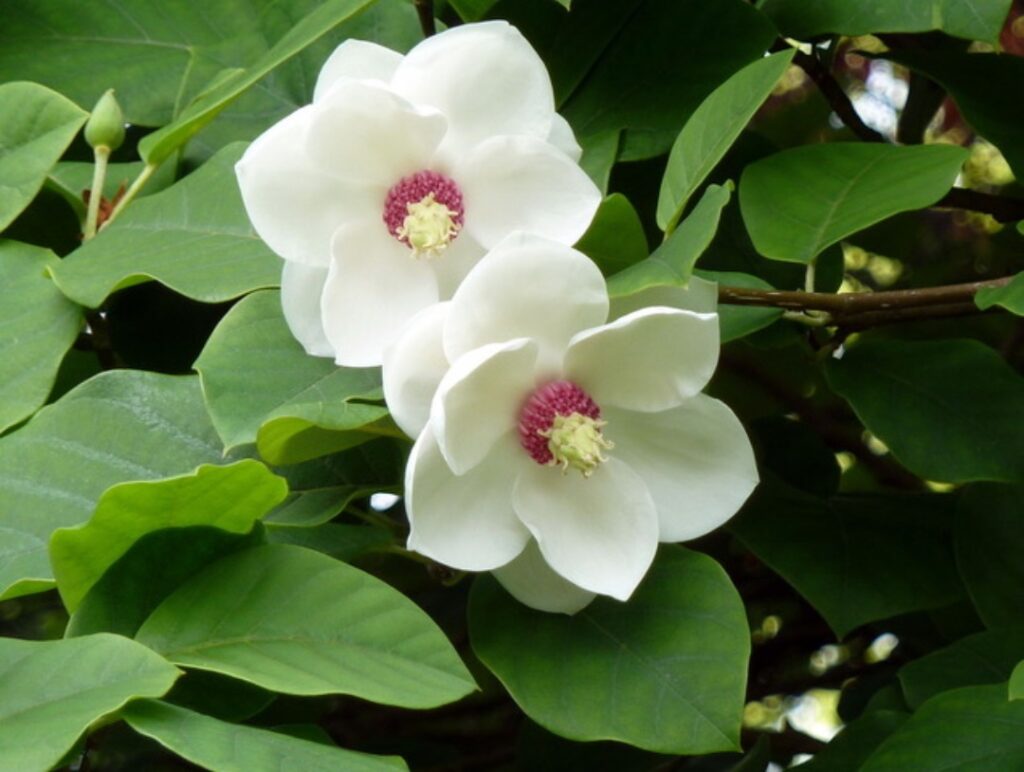
Wendy Cutler, CC BY-SA 3.0
North Korea
Mokran
Magnolia sieboldii

Wendy Cutler, CC BY-SA 3.0
General Description / Cultural Significance
Magnolia sieboldii, also known as the Korean Mountain Magnolia, is endemic to Korea, blooming throughout the summer. Fittingly, it is considered one of the hardiest Magnolias and can thrive in difficult environments. Called mongnan or mokran in Korean, it is the DPRK’s national flower, but shares that status with the more culturally contrived choices of Kimjongilia and Kimilsungia, named after two of the country’s late leaders, Kim Jong-Il and Kim Il-Sung.
According to North Korean legend, as reported by the DPRK’s official tourism website, “One year when he visited Mt. Jongbang, President Kim Il Sung told some officials that he had seen a beautiful flower in the mountain in the days of Changdok School, asking them to find out its whereabouts… He did not forget the flower even in the days of the anti-Japanese war. Later the flower was discovered in the mountain under the deep care of General Kim Jong Il.” Following the North Korean tradition of adding the suffix “-ran” to flowers considered beautiful, Kim Il Sung named the flower “mokran,” translating literally to “beautiful flower growing on a tree.”
The tree has a long history of being appreciated by the Korean people and has served as part of their traditional medicinal sources: “The aromatic bark contains magnolol and honokiol, two polyphenolic compounds that may have demonstrated anti-anxiety and anti-angiogenic properties. Magnolia bark also may have been shown to reduce allergic and asthmatic reactions.” The interest in its healing properties continues today, as “Magnolia has attracted the interest of the dental research community because magnolia bark extract inhibits many of the bacteria responsible for caries and periodontal disease. In addition, the constituent magnolol interferes with the action of glucosyltransferase, an enzyme needed for the formation of bacterial plaque.
Climate Change / Conservation Status
North Korea still relies on coal for energy production. High air pollution from coal continues to have increasing health and environmental effects. The country’s pollution mortality rate is the highest in the world.
Germanwatch’s Climate Risk Index, estimates that North Korea was the seventh hardest hit by climate-related extreme weather events of 179 nations during the period 1992–2011. In 2022 typhoons, flooding and sea level rise were increasing.
Alternate Names
Korean mountain magnolia
Oyama magnolia
Sources
Hewitt, Giles, “North Korean Flower Show Features Rockets, Grenades, And A Begonia Named After Kim Jong-Il,” Business Insider, 26 July 2013 http://www.businessinsider.com/north-korean-flower-show-2013-7
Permanent Mission of the Democratic People’s Republic of Korea to the United Nations.
Naenara. “National Flower of the DPRK” Democratic People’s Republic of North Korea. https://web-beta.archive.org/web/20151001212116/http://www.naenara.com.kp/en/great/symbol_view.php?3
Soldo. “The Evergreen Magnolia: Flower From Ancient Times” March 2011. http://flowerisblossoms.blogspot.com/2011/03/evergreen-magnolia-flower-from-ancient.html

